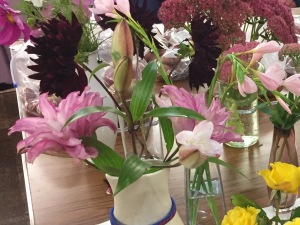Our recent Zoom talk featured Adam Pasco, horticultural journalist and editor of Gardeners World magazine for many years, who provided ten tips and ideas on how to create a garden for all seasons that would provide garden interest and colour throughout the year. He used as a backdrop and example his own beautiful back garden in Peterborough which he had created over the last 30 years. A garden that we amateur gardeners could relate to and achieve.
1) CHOOSE PLANTS WITH STRUCTURE AND FORM: Adam suggested as examples, the Wedding Cake Tree – Cornus controversa variegata, Hydrangea paniculata, Cardoon – Cynara cardunculus.
2) PICK PLANTS THAT HAVE A LONG SEASON OF INTEREST: He suggested putting the perennial Spanish Dagger – Yucca Gloriosa variegata in a large pot and surrounding it with annual bedding plants which could be changed each season.
3) USE PLANTS AND COMBINATIONS FOR CONTINUITY OF COLOUR: For example Phlomis russeliana (AGM) and Nepeta racemosa.
4) ADD FEATURES AND FOCAL POINTS: He gave examples such as seated areas with benches, painted wooden fences, paths, arches and water features. He gave East Rushton Old Vicarage garden, Barnsdale Gardens, and Old Wallerton Hall as examples.
5) CREATE STUNNING SEASONAL DISPLAYS: So that you have a display in each season. He gave the red border at Hidcote as an example of a summer display.
6) ADD VALUE ACROSS ALL SEASONS: Also design your garden so that it looks good all the year round. Focus on one area that looks good for one season. Adam suggested Camellia ‘Garden Glory’ Feb – March, dwarf Rhododendron ‘Snipe’ Feb – March, Camellia ‘Contribution’ Mid March-April, Skimmia x confusa ‘Kew Green’ (AGM) – April, Lithodora ‘Heavenly Blue’ – Spring through summer, Azalea ‘Sheila’ – May, Rhododendron ‘Yakushimanum’ – May, Rhododendrum ‘Surrey Heath’ – May, Kalmia latifolia -Early June, Clematis ‘Oh La La’, Boulevard Series, Hydrangea -Summer into Autumn, Taxus baccata ‘Standishi’ (AGM) -Year round, Tibetan Cherry Prunus serrula.
7) EXCITE THE SENSES: He suggested sensory plants such as Nemesia ‘Wisley Vanilla’ and Lilium ‘Pink Romance’.
8) GROW SOMETHING DIFFERENT: He suggested Sophora ‘Sun King’ (AGM), Hollyleaf Sweetspire, Itea ilicifolia (AGM), Phygelius ‘Moonraker’ and Ptilotus ‘Joey’ for a sunny patio pot.
9) PLANTS THAT ATTRACT WILDLIFE: He suggested Alstromeria initicancha ‘Sunshine’ and Cotoneaster horizontalis for berries.
10) HAVE A STAR PLANT FOR EVERY MONTH:
EARLY SPRING: Plant Narcissus ‘Tete- a- Tete’, Camellia x Williamsii ‘Saint Ewe’ (AGM) and Summer Snowflake ‘Leucojum aestivum (AGM) with Brunnera Jack Frost (AGM).
MID SPRING: Star Magnolia – Magnolia stellata, ornamental fruit and trees e.g Self fertile Pear ‘Concorde’ (AGM), Epimedium x Perralchicum ‘Frohnleiten’.
LATE SPRING: Rhododendron ‘Yakushimanum’ (AGM), Perennial Wallflower Erysimum ‘Bowle’s Mauve’, Clematis koreana ‘Amber’.
EARLY SUMMER: Roses including ‘Gertrude Jekyll’ and ‘The One and Only’, Allium ‘Globemaster’ (AGM). Annual climbers e.g. Sweet Peas, Thungbergia alata ‘Superstar Orange’, Spanish Flag – ‘Ipomoea lobata’, Cup and Saucer Vine – Cobaea scandens.
MID SUMMER: Astranta major ‘Roma’ (AGM), Echinacea magnus, Lavender Fathead ‘Pretty Polly’, ‘Willow Vale’, L. Viridis.
LATE SUMMER: Crocosmia ‘Lucifer’ (AGM), Rudbeckia ‘Goldstrum’ (AGM), Sedum Thundercloud’, ‘Purple Emperor’ (AGM), ‘Rose Carpet’, Sedum takesimense ‘Atlantis’.
FOLIAGE FAVOURITES THROUGHOUT THE SEASONS: Acer shirasawanum ‘Aureum’ (AGM), Euphorbia ‘Ascot Rainbow’ (AGM), Brunnera ‘Jack Frost’ (AGM), Persicaria ‘Red Dragon’, Physocarpus ‘Diabolo’ (AGM), Elder – Sambucus ‘Black Lace’ (AGM), Viola ‘Heartthrob’, Acer palmatum ‘Seiryu’.
EARLY AUTUMN: Perennial Sunflower – Helianthus ‘Lemon Queen’ (AGM), Aster x Frikarti ‘Monch’ (AGM), Japanese Anemones ‘Pretty Lady Susan’ ‘Honore Joubert’ (AGM), Prinz Heinrich ‘Pamina’ (AGM) and ‘September Charm’ (AGM).
MID AUTUMN: Autumn colour- Stag’s Horn Sumach – Rhus typhina, ‘Kashmir’, Rowan – Sorbus ‘Cashmiriana’ (AGM).
LATE AUTUMN: Crab Apple – Malus ‘Red Sentinel’ (AGM), Skimmia japonica ‘Pabella’ (female for berries).
EARLY WINTER: Silver Birch – Betula ‘Silver Shadow’ (AGM).
EVERGREEN FORM AND COLOUR FOR ALL SEASONS: Japanese Sedge – Carex ‘Evergold’, Helleborus argutifolius (AGM), Skimmia ‘Kew Green’ (AGM) (male), Chamaecyparis ‘Boulevard’ (AGM), Choiysia ‘Aztec Pearl’ (AGM), Choisya ternate ‘Sundance’ (AGM), Hebe ‘Margaret’ (AGM), Evergreen Fern – Soft Shield Fern Polytsichum setiferum (AGM).
MID WINTER: Mahonia x Media ‘Winter Sun’ (AGM), Daphne bholua ‘Jacqueline Postill’ (AGM), Winter Aconite – Eranthis Hyemalis (AGM),
LATE WINTER: Crocus ‘Tricolor’ (AGM), Snowdrop – Galanthus nivalis (AGM).
Finally, Adam suggested garden jobs for April: it is a good time to transplant and split Agapanthas. Also he recommended buying seeping hosepipes, and that timers could be attached to taps. A time too for testing old seeds to see if they are worth using. Take a few, soak in water overnight, dry them and cover them with cling film. Check after a couple of days to see how many have germinated.
Angela
Adam Pasco launched the BBC Gardeners’ World magazine in 1991 and edited it for 22 years, he currently edits the Waitrose magazine, and has worked alongside gardening icons Geoff Hamilton, Geoffrey Smith and Alan Titchmarsh; he also lectures, is a renowned photographer and runs his own media company, adampascomedia.com































